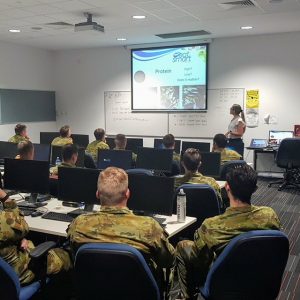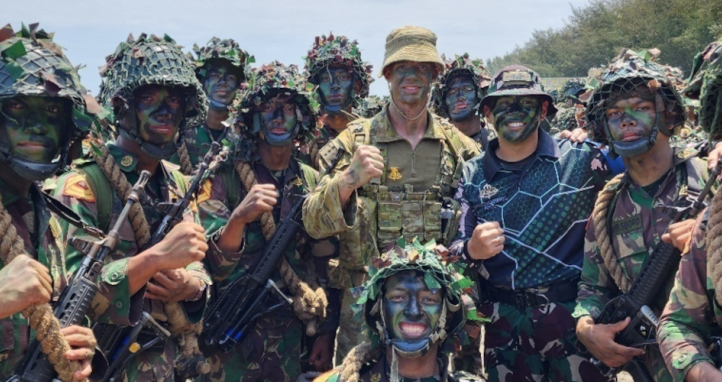Introduction
The nature of service within the Australian Army will sometimes see soldiers become wounded, ill or injured (WII) from a combination of different sources, including operational service, sports, military training, or a pre-disposition to mental health illnesses. In his article 'Idiots, Imbeciles and Moral Detectives: Military and Government Treatment of Mentally Ill Service Personnel and Veterans'¹, Muir argues that 'the wellbeing of service personnel and veterans … has always been secondary to the primary concerns of the military’ (Muir, 2002, p. 41). Fortunately this has changed. As a result of campaigns in Iraq, Afghanistan and East Timor, which saw increasing casualty numbers, the spotlight has turned to the WII soldiers returning from operations and since 2006, the Australian Government has spent millions of dollars investing in the rehabilitation of WII soldiers by developing recovery centres, investing in WII programs, rewriting doctrine to create processes for rehabilitation, as well as funding significant research and development of prehabilitation programs within training organisations (Australian Defence Force Rehabilitation Program). This article will focus on the development of 8th/9th Battalion Royal Australian Regiment's (8/9 RAR’s) Rehabilitation and Transition Platoons as a framework for getting soldiers back to work faster, or supporting them to transition with dignity. It also introduces other options to educate and support soldiers in injury prevention.
8/9 RAR’s Rehabilitation and Transition Pre-2018
Prior to 2018, 8/9 RAR’s status quo for rehabilitation within the Battalion was that those soldiers who were Medical Employment Classification (MEC) 3 (rehabilitation) remained within their current company. They were given their rehabilitation program by the medical staff and were to complete it within their companies while continuing to work within their medical restrictions. Those soldiers who were MEC 4 (employment transition) or MEC 5 (medically unfit for further service) were given an internal posting order to Transitions Welfare Cell (TWC) to allow them to prepare for corps transfer or transition. The MEC 3 soldiers who could not remain within their companies were also moved to TWC and often filled their days working in the Battalion coffee shop. TWC was commanded by a major (MAJ) and a sergeant (SGT) who worked tirelessly to support these soldiers; however, the sheer number of MEC 3, MEC 4 or MEC 5 soldiers ultimately meant little supervision for those completing their rehabilitation or trying to transition. This lack of supervision and support for the WII (simply due to the ratio of WII soldiers to available supervisors) meant that the majority of soldiers were not rehabilitating within their prescribed time-frames. Additionally, in some instances their physical injuries were compounded due to significant weight gain and some suffered degradation of their mental health due to their perception of being a ‘malingerer.’ A consequence of this was that some soldiers who had initially been classified as requiring rehabilitation were now also medically transferring or transitioning.
Rehabilitation and Transition Concept 2018
In January 2018, the Commanding Officer (CO) 8/9 RAR, Lieutenant Colonel Tony Bennett DSM, split TWC into two organisations: Rehabilitation Platoon, and Transition Platoon. Rehabilitation Platoon has three lines of effort: the first is that all MEC 3 soldiers from across the Battalion are to be posted into the platoon; the second is that they are to remain there for the shortest amount of time possible; and finally they are to continue their military training and education. Rehabilitation Platoon’s full-time chain of command is one captain (CAPT) and a senior warrant officer class two (WO2). The role of Rehabilitation Platoon is to be a key enabler for the soldiers to gain access to the broader initiatives within Army’s Support to the Wounded Ill and Injured Program (A-SWIIP). The second organisation is Transition Platoon. This platoon is staffed by the original MAJ and SGT; and any soldier who is MEC 4, MEC 5, or within one month of discharging, is internally posted there. The direction from the CO is that the platoon is to ‘transition soldiers with dignity’. Transition Platoon soldiers are given access to on the job training (OJT), on the job experience (OJE), and transition seminars as well as being supported through the process of transitioning.
 Rehab Pl members supporting Legacy
Rehab Pl members supporting Legacy
Change Management
Throughout the process of raising Rehabilitation Platoon, it was vital to carefully manage the perception of what Rehabilitation Platoon is, both for those posting in and those watching from outside. In his textbook Managing Organisational Change, Jabri describes a narrative as ‘giving a meaning to change in life’ (Jabri, 2017, p. 82). It is imperative for the success of the Platoon that the narrative shows the soldier (the person who is most affected by the change) that by coming to Rehabilitation Platoon they will have more access to support and it will enable them to return to work faster than if they remained in their rifle company. Additionally, Rehabilitation Platoon is not to be seen as a ‘dumping ground’ for those soldiers who are injured. This narrative was initially created by the chain of command ‘through education and communication and by facilitating support and agreement’ (Jabri, 2017, p. 242). What surprised me, was that once the initiative was in place, and the Platoon had been operating for a few weeks, the ‘digger net’ took over creating a narrative that evidently supported the initial concept. The two narratives ‘created trust in the change project, the organisation and the management’ (Yukesk & Bekmerer-Feuerhahn, 2013, p. 182²) and supported a successful raising of the Platoon.
A key rebuttal from those who initially thought the concept of a Rehabilitation Platoon would ultimately fail was that ‘you shouldn’t take soldiers away from their mates.’ In order to reduce the potential stress of a soldier being removed from their company and their mates we structured the platoon by company sections, led by injured non-commissioned officers (NCOs) from that company. Additionally, our military education/training is structured around the same activities that each company is undertaking. If Alpha Company (A Coy) is conducting airmobile operations, the A Coy section is revising and practising airmobile standard operating procedures and tactics, techniques and procedures (SOP/TTPs). This allows the soldiers to remain connected to their company, and also facilitated a faster reintegration back to their rifle company when they are eventually upgraded.
Creating this positive environment for soldiers, mirroring the training of the rifle companies, allowing direct and increased access to medical professionals, as well as providing supervised physical training (PT) with a detailed training program, has given the members of Rehabilitation Platoon a purpose within the Battalion. They recognise the benefits of the rehabilitation, they have set goals (and are achieving them much faster than policy dictates), and the perception of 'malingering' has disappeared within the Battalion.
Countering the ‘Malingerer’ perception
Every battalion within the Royal Australian Regiment has injured soldiers, both legitimate and others who are thought to be milking the system. Unfortunately for those soldiers who are desperately trying to get back to MEC 1 (fully employable and deployable), they may get cast aside and their mates take up the increased workload; this can cause the perception that the soldier is ‘malingering’. A key part of 8/9 RAR’s Rehabilitation Platoon is to ensure that the Platoon is seen as an active organisation, who at all times is working as hard as the remainder of the Battalion. We do this by ensuring that all soldiers attend PT at the same time (just like in a rifle company) in the Battalion gym (meaning they are visible to other members of the unit). Additionally, like the rest of the Battalion the soldiers are always in uniform, unless they are doing PT. Their tasks are varied, including for example supporting exercises by running simulations and making regular visits to the Lady Cilento Children’s Hospital. Their actions show the other soldiers of the unit that Rehabilitation Platoon is not a ‘dumping ground’ for the WII, but is a group of people working hard to return to MEC 1 or to a point that they can corps transfer.
Throughout the Battalion, junior non-commissioned officers (JNCOs) and soldiers are commenting on the positive outlook of the soldiers posted to Rehabilitation Platoon as well as on the work they are doing to return to MEC 1. The soldiers' morale is significantly higher than has been the case with previous rehabilitation concepts and the soldiers are being upgraded faster than they thought possible. We also ensure that any member who had been upgraded and is returning to their company is celebrated and congratulated for their hard work. Any ‘malingerer’ perception has fast become a thing of the past and the members of the Platoon feel comfortable with the position they are in.
 Rehab Pl receiving nutritional support
Rehab Pl receiving nutritional support
Transition Platoon
Transition Platoon supports MEC 4 or MEC 5 soldiers as they transition to another corps or out of Defence. As part of enabling members to transition with dignity, Transition Platoon supports them in submitting their Department of Veterans Affairs (DVA) paperwork, and enables them to conduct OJT or OJE within Defence or in the civil sector while they are waiting for their separation or transfer date. Ultimately, the aim of the Platoon is to give the member the best chance of success after their time within the Battalion. Sure, some soldiers are happy to cruise through to their discharge without the assistance of the aforementioned initiatives. However, for the majority of soldiers, what we have found is that they actually need all the support we can muster and appreciate the preparation for transfer out of Defence: for example, most of them do not know how to write a resume or prepare for a job interview. With this new initiative, no soldier transitioning from the Battalion can slip through the cracks and leave Army without our support. At quarterly unit welfare boards (UWBs), the resounding comment from soldiers transitioning has been ‘thank-you for the opportunities that we have been able to access while transitioning; with multiple members offering to return and assist others through the process.
Complex Cases
Within Rehabilitation Platoon there are numerous soldiers who have been classified as complex cases or have been MEC 3 for up to 48 months. The benefit of Rehabilitation Platoon is that it enables us to work with the medical professionals for each PM 101 (medical advice) or rehabilitation program they issue. We ensure that every program is tailored to the individual, and work with the rehabilitation consultants (who occupy the office next door) to create SMAART goals (specific, measurable, actionable, attributable, realistic and timely), that then allow the CO to hold members accountable for through the UWB process. What we have found is that personnel who have complex medical cases are getting better, and those soldiers who were long-term MEC 3 are making their own decisions to transfer or return to the rifle company.
Nutritionist Support
In January 2018, 8/9 RAR had 109 members MEC 3 or below. In eight months this number has reduced to 72. This is a reduction from 16% to 11% of unit personnel holding this medical classification. While the 8/9 RAR rehabilitation and transition concept seems to be positive, there is still significant progress to be made to support soldiers in the Battalion. We have enlisted the support of a nutritionist to educate the Rehabilitation Platoon soldiers on the dietary changes required after injury, as well as foods that support the healing of injuries for a faster rehabilitation. They have also developed specific programs for those members who are required to lose weight. So far, this has been a successful initiative, with all soldiers commenting on the positive impact it has had. However, hiring a nutritionist to support the member after they have been injured or ordered to lose weight is realistically too late; if we are to actually treat our soldiers like athletes, access to tailored nutritional support is required for all soldiers, not just those who are MEC 3 or below.
Tactical Athlete Development Program
The Battalion has developed the Tactical Athlete Development Program (TADP) which has so far proved to be a success, with all members showing significant signs of athletic performance improvement. The soldiers of Rehabilitation Platoon all participate in the program, with exercises tailored to support their rehabilitation as required. By participating in this program it negates the requirement for specific ‘return to infantry’ programs as they have continued with their training throughout their downgrade.
Investment into injury prevention programs is essential. Infantry soldiers are required to carry significant equipment loads over long distances; physical training needs to be structured around this requirement (as occurs with the TADP). By hiring specialists (eg. exercise physiologists) that soldiers have regular and easy access to, supports soldiers in injury prevention as well as potentially decreasing the amount of soldiers being medically downgraded. These specialists need to be embedded within the battalion environment so that they know each member personally and can regularly monitor each individual to support their needs.
The ADF has spent millions in recent years in rehabilitation. The rehabilitation program ‘is a multi-disciplinary strategy aimed at maximising a member's potential for restoration to their pre-injury physical, occupational, social, psychological and educational status’ (Australian Defence Force Rehabilitation Program, 2016). However, there has been minimal investment in pre-injury support for our soldiers. Increased initial investment in the above areas within the infantry battalions, will support the concept of the tactical athlete and will potentially reduce the current burden on the medical system as well as reduce the number of soldiers being medically downgraded. This in turn will increase the number of soldiers who are ready and deployable at any given time.
Conclusion
This article has focused on the development of 8/9 RAR’s Rehabilitation and Transition Platoons as a framework to getting soldiers back to work faster or supporting them to transition out of the Army with dignity. Through careful management of both organisational change and implementation, any perception of soldiers ‘malingering’ has all but disappeared. Our medically downgrade statistics are decreasing, soldiers are finding meaningful work during their rehabilitation, and those who are leaving Defence are transitioning with a positive outlook on their final days at 8/9 RAR. Although there has been significant progress in these areas, there is still more to be done in supporting these members within the battalion environment. While each battalion approaches rehabilitation and transition differently, more investment is required across Army to provide soldiers with education and injury prevention measures, particularly in infantry units, in order to reduce the amount of downgraded personnel within the medical system.




